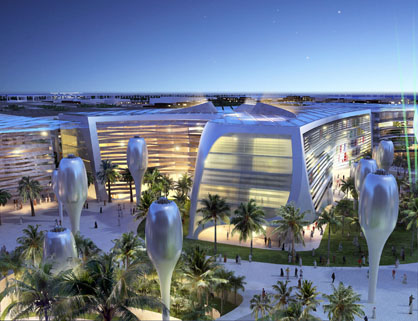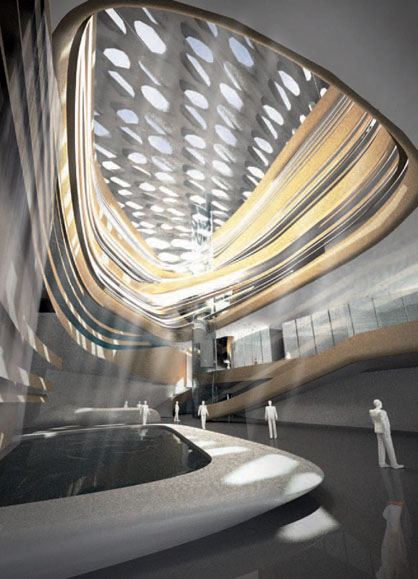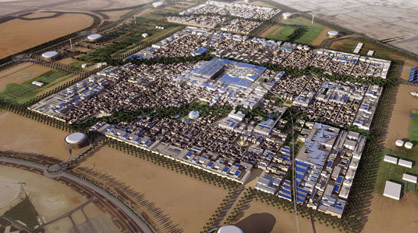| home > files |
| Interview with Tobias Wallisser (LAVA) Silvio Carta |
||||
| The directors of LAVA (Laboratory for Visionary Architecture) Chris Bosse, Tobias Wallisser and Alexander Rieck have, in a way, a fairly conventional professional background: they graduated from university, practiced in an office and became more experienced over time. Their names appear in more than their fair share of some of the most well-respected architecture firms worldwide. They have, for example, worked on Beijing's Watercube swimming centre and Stuttgart's Mercedes-Benz Museum, among many other projects in Vietnam, the Middle East, Japan, the USA and across Europe. After attaining a certain professional level, some architects opt to dedicate themselves to the projects of one particular office and to rise to a position of responsibility, perhaps becoming a partner. Others choose to quit working for an established firm to start their own practice. LAVA's founding members chose the latter route. But once set up, LAVA's methods began to feature such innovation that they could be considered as a new approach to a worldwide design process. LAVA set up two offices, one in Sydney and one in Stuttgart and the firm works with a site office in the UAE. An essential part of LAVA is the connections it has built up during the years of practicing architecture, a net that spans the globe. Pivotal to the practice is Fraunhofer-Gesellschaft, a German-based research organization consisting of several institutes; it carries out applied research which is directly used by private and public enterprises. Fraunhofer's clients are from the service industry and public administration sectors; its staff includes scientists and engineers. The theoretical research provided by Fraunhofer is based on scientific study and economic development and so requires a practical application. It is at this stage that designers like LAVA step into the process. They investigate the ways in which the results can be applied to building practice through architectural means. SILVIO CARTA. What is the difference between a conventional architecture firm and LAVA? TOBIAS WALLISSER, The main difference is that when we get up we have 20 emails from the other members of the practice. We are a virtual office, which means that not everyone who works for and with us is in the same place. I work with people I have never seen. The biggest challenge is to make sure that the Sydney, Stuttgart and Abu Dhabi offices are synchronized. You always have to bear in mind that you have a 24/7 office: around midnight our time Sydney starts working, and that means that a day and night division no longer exists which means no time is wasted; architecture has to be quick. The work that LAVA does is really to unite all the parts involved in the process. We are not suggesting new roles for architects, we are just rethinking our position in the whole. What is the influence of the Fraunhofer Institute on LAVA's design? The researcher who invented the MP3 didn't think of applying its format to create a walkman. Fraunhofer studies how society is changing and what the needs of the world will be in 20 years. Fraunhofer has several departments, each involved in different aspects of technology from super precise photocells to the newest elevator components. Their research focuses on single products, but understanding how to use them or combine them and come up with entirely new scenarios is the next step. I believe architecture is connected with that very element, if you think about it as a powerful tool at the interface between a product and a human's needs.  Laboratory for Visionary Architecture. Masdar Plaza, Oasis of the Future (2009-2013). Perspective Hotel. As we have to supply new ideas to companies working with Fraunhofer, our role is to demonstrate where and how the research is applicable. Our concepts have to be strong enough to convince clients and the public that the new scenarios we are illustrating are workable. Our role lies between that of a designer and a researcher, but what we do is different from both: we are constantly generating ideas within our teams. The strength of a virtual office is that you can work in association with a very wide range of people with different skills. You have said that architecture has a role in combining human needs and technological progress. Do you have an example? We recently took part in Future Hotel, a research project led by the Fraunhofer Institute that forms part of the Inhaus Project in Duisburg. We investigated the scope of the next generation of hotel spaces, which we developed in conjunction with several industry partners. The prototype generated is characterized by a calm yet stimulating space as we designed a room where all the infrastructure and services are integrated into a continuous wall system. A combination of fluid yet edgy forms shaped from hard and soft materials provides a contemporary atmosphere. Acting as a flexible interface between a person and the surrounding space, cutting-edge technologies and services provide new levels of quality and individual control for guests. Tell us about a joint venture you have undertaken with another office. The LBBW project in Stuttgart is a pretty good example. The technological façade, which features in the building, was developed with Transsolar, a climate engineering firm with offices in Stuttgart, Munich and New York, and the engineer Werner Sobek. The façade system is constructed in two parts: the first contains insulation and all the technical layers (we can consider it as a standard façade) and the second is defined as a metal mesh that contains metal discs. The function of the discs is to optimize the availability of Stuttgart's sunlight: on one side the surface of each disc is treated so it reflects daylight into the interior spaces, and in the other side it is a photovoltaic panel. The discs are controlled by computer and are rotated according to the amount of light available. By changing the angle at which the discs are positioned, the use of the available light is optimized.  Laboratory for Visionary Architecture. Boutique Hotel Study UAE. This feature works with the other side of the façade which is made of translucent glass with small capillarity and contains algae. It functions by drawing external air into a photosynthesis cycle and so converts light into chemical energy (a by-product of which is the consumption of carbon dioxide and water), releasing, among other things, oxygen. The building has, consequently, a reduced consumption of energy, while at the same time it produces energy. The glass is whitish but, because of the chemical reaction triggered by light, it turns a green color giving the feeling that there is something positive happening. So the clients have a zero-energy office building combining a high-quality public-domain-appropriate frontage with a resource-optimized workplace. That's what we call technology with artificial nature. Beside the Fraunhofer how do you succeed in pushing forward your design? When we got the commission for a residential tower in Abu Dhabi –named after Michael Schumacher– we immediately thought of involving a local studio which was already part of LAVA's network: Wenzel+Wenzel, an architecture firm with offices in Stuttgart and Abu Dhabi. They are registered architects in UAE, and now they take care of the technical aspects of our projects. To be honest, we couldn't have done such a design without a partner office like them. We contribute to the design as experts in 3D modeling and in creating spaces and they ground our ideas with their technical expertise. But we don't believe in separating the organization of work; it's too dangerous. We would risk losing control of the design idea itself. We prefer to collaborate from the early stages with a company like Wenzel+Wenzel: they grow into the project, they understand the idea from the beginning. A project has to grow through everybody's contribution. For instance, the façade of the Schumacher Tower has a continuous surface that enables a certain curvature with a lot of repetition, and the potential for standardization in the building process. State-of-the-art engineering and innovative materials are used to achieve a fully sustainable performance. There are fins which track the sun, control the solar shading and dissolve the rationality of the plan into a continuously evolving built volume.  Laboratory for Visionary Architecture. Masdar Plaza, Oasis of the Future (2009-2013). Bird's View Masdar. Does this network approach to architecture stem from your professional background or your age? I think both. One thing we learned from Michael Schumacher, while working on the residential tower, is: 'First do your best, then you see what the others are doing,' and I think that is exactly what we do in our practice. Of course we are interested in what others are doing, but we want to pursue our own ideas. The way we work is just our way of creating designs that are genuine and good. Too many architects spend time promoting themselves. We just strive for quality by doing our best. We use computers, the internet, networking systems, VRML technology [3D interactive vector graphics] and everything we regard as useful to push ourselves in terms of our design. This is the only way we believe we can achieve that. We have to admit though, that all those tools that aid the way architects work have only come to fore over the last two decades.  Laboratory for Visionary Architecture. Masdar Plaza, Oasis of the Future (2009-2013). Bird's View Masdar Plaza Day, Open Umbrellas. Will LAVA's set up remain the same in the future, or is this just a phase in the evolution of your practice? What would be the next stage in a network architecture such as yours? Other offices in Germany have developed a network architecture-style approach, like Graft for example. I could imagine that in the future LAVA will have different companies in different countries, with each one having grown locally and with their own in loco contacts. Of course, the companies must be part of the network, which means they share the ideas and results with everybody in the network. There should be enough space for additional people who want to be involved too, but it would be great if the headquarters were the same size as the other cells, for instance. So are you saying that the archistar period is going to change soon? Definitely. The market rules are still dominated by their presence, but in a way I feel that times are changing. As a director at LAVA I certainly have responsibilities. I have to lead the office and make sure that everything is moving forward, but the difference is that we are not so worried about separating what is mine and what is yours. The crucial part is understanding what the new setting for architectural practices will be. The orientation of work worldwide has the potential to match very specific local elements with a huge global knowledge, something that's hardly achievable with a process based on a big archistar's ego. |
[May 7, 2010] |
|||
| This interview, hold on November 28, 2008 in Amsterdam, has been first released by "MARK" magazine, 18, Another Architecture, 2009). Texts and images courtesy of David Keuning ("MARK") and Tobias Wallisser (LAVA). | ||||
| > LAVA | ||||
|
||||
Per
qualsiasi comunicazione laboratorio
|